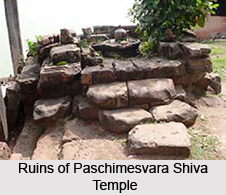 The Paschimesvara Shiva Temple, an ancient Shaivite temple dedicated to Lord Shiva, is located in Badu Sahi, in the temple city of Bhubaneshwar in the Indian state of Orissa. The pilgrimage centre is situated on the south-western embankment of the Bindusagar Lake. It is for this reason that the temple is known as Paschim meaning west by the locals residing here. The religious edifice is positioned in Latitude 20°14`46 and Longitude 85°50`02 at an average elevation of 61 ft above the sea level.
The Paschimesvara Shiva Temple, an ancient Shaivite temple dedicated to Lord Shiva, is located in Badu Sahi, in the temple city of Bhubaneshwar in the Indian state of Orissa. The pilgrimage centre is situated on the south-western embankment of the Bindusagar Lake. It is for this reason that the temple is known as Paschim meaning west by the locals residing here. The religious edifice is positioned in Latitude 20°14`46 and Longitude 85°50`02 at an average elevation of 61 ft above the sea level.
Architecture of Paschimesvara Shiva Temple
The dawn of the 8th century A. D. stood as a witness to the establishment of the Paschimesvara Shiva Temple that belonged to the Bhauma Epoch. Failing to withstand the savages of time, the superstructure of the temple had collapsed long ago. However, the stylistic development of the temple and features suggest that the temple must have faced the western side. The temple houses ruined sculptures of Kartikeya, Lord Ganesha, Parvati and Narasimha. Presently, the pilgrims visiting the temple can witness a Shivalingam installed over a heap of stones that can be reached by climbing a flight of steps from the western side.
Paschimesvara Shiva Temple is enclosed on the western side at a distance of almost 15.5 meters by the Markendesvara Shiva Temple, on the north-west corner at a distance of almost 2 meters by Akhdachandi temple, on the eastern side at a distance of 1.5 meters by the Bindusagar and on the southern side by some private residential buildings. Mostly sandstone and laterite have been employed for the construction of the temple. The construction style is of dry masonry type.
Besides these, four detached sculptures can be seen on the north side of the ruins. One of them is an idol of Parvati having four arms holding in her upper right hand a rosary and in her upper left hand a nagapasa. Two female attendants as well as two animals can be seen at the base the deity on its either side. Two flying vidyadhara on either side can be seen carrying garland in their hands. The second sculpture is that of Lord Ganesha seated on a decorated pedestal flanked by two jackfruits. With his upper left hand the deity is seen carrying a parsu and with his lower left hand he carries a modaka patra while with his upper right hand he holds a rosary and his lower left hand is broken. The vehicle of the Lord, a mouse is seen missing. The design and the construction suggest that the deity dates back to the 7th - 8th century A.D. A two armed Kartikeya also seen sitting on his mount a peacock in lalitasana is the third detached sculpture of the temple while the fourth detached sculpture is a four armed idol of seen in his ugra form posing on a beautifully decorated pedestal. A deulacharini can be seen in front of the Narasimha.
The temple celebrates grand festivals such as Shivaratri and Sankranti with great zeal and enthusiasm drawing pilgrims from various sections.





















